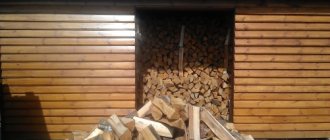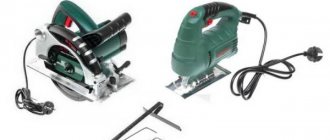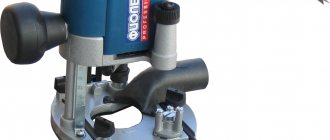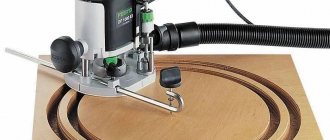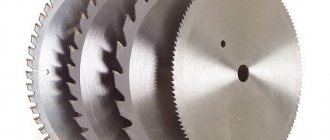It is extremely difficult to overestimate the need for a wood saw in the household. This simple tool is a reliable and faithful assistant when renovating an apartment or building a country house; it can be useful when improving a summer cottage or comprehensive garden care. However, before you go to the store, it would be useful to find out its technical and operational characteristics. Read more about how to avoid mistakes when choosing a hacksaw for wood later in our article.
Basic parameters of hand tools for cutting wood
A hacksaw is one of the most necessary tools in every man's inventory. This device allows you to easily change the dimensions of wood and plastic lumber. Using a hacksaw, you can perform a lot of operations in construction, cut branches in the garden, shorten fence poles, and so on.
A hand saw is used to work with lumber
But when purchasing such a seemingly simple tool, not everyone thinks about how to make the right choice and what criteria need to be taken into account. A hacksaw has its own special parameters that can affect the quality of work. There are four basic parameters when choosing a hacksaw: blade length, tooth size, steel type and handle type.
Blade length
For ease of use, the length of the hacksaw blade is chosen so that it is twice the size of the material at the cut site. This allows you to effectively remove sawdust during work due to the fact that all the teeth of the blade will come out of the board/log. In addition, this ratio of the size of the hacksaw and lumber contributes to a greater range of hand movement. This, in turn, takes much less effort. In construction, a universal hacksaw with a blade length of 45–50 centimeters is most often used. To work with small bars and boards, a blade 30–35 centimeters long will be sufficient.
Tooth size
This is perhaps the most important parameter. After all, the speed and accuracy of cutting depends on the size of the tooth.
.
The number of teeth per inch of blade is usually denoted by the TPI coefficient. To work more accurately with the material, it is necessary to use a hacksaw with a high TPI coefficient, that is, with a large number of teeth. When choosing a blade with a TPI of at least 7–9, and a distance between teeth of no more than 2–4 mm, the surface at the cutting site will be smoother and without torn edges. For working with large beams and garden trees, a blade with a TPI of 3–6 and a tooth spacing of over 4 mm will work well. Using such a hacksaw will reduce the effort required and increase the speed of cutting the working material
.
Tooth pitch correspondence table
| 1 TPI = 25.5mm | 10 TPI = 2.5mm |
| 2 TPI = 12mm | 11 TPI = 2.3mm |
| 3 TPI = 8.5mm | 12 TPI = 2mm |
| 4 TPI = 6.5mm | 13 TPI = 2mm |
| 5 TPI = 5mm | 14 TPI = 1.8mm |
| 6 TPI = 4mm | 17 TPI = 1.5mm |
| 7 TPI = 3.5mm | 19 TPI = 1.3mm |
| 8 TPI = 3mm | 22 TPI = 1.1mm |
| 9 TPI = 2.8mm | 25 TPI = 1mm |
Sharpening teeth
The usual triangular shape of hacksaw teeth is taken as standard. The teeth are made in the form of an acute triangle or isosceles, depending on the purpose of the cut. Such a blade can be sharpened with particular ease by repeating all the angles of the teeth. This blade can be used for both longitudinal and transverse cuts to avoid rough notches.
The teeth of a classic hacksaw are made in the shape of a triangle and can be sharpened
Video: self-sharpening hacksaw teeth for wood
But modern hacksaws, unlike classic ones, have hardened teeth with a non-standard trapezoidal shape. Such saws are endowed with increased strength and are resistant to wear. Their steel cannot be sharpened, and it is very difficult to maintain all the angles of the sharpened teeth.
Modern hacksaws are made with hardened teeth in the shape of a trapezoid.
Steel type
High-grade stainless steel is most often used to produce hacksaw blades. Typically, wood saws are made of steel with a hardness of HRC45. Very often, manufacturers combine steel in the canvas. In a hacksaw with a combined blade, the majority is also made of steel 45, but the cutting part is made of steel 55 and 60. When the cutting edge is hardened, wear resistance increases.
This type of tool can be easily distinguished from a regular hacksaw by its dark, hardened teeth.
The first forged saws were made in Ancient Greece. Forging gave high hardness to the metal and improved the quality of the tool.
Handle type
The ease of use of the saw depends on the correct choice of saw handle. Handles are made of wood or plastic. A very important point is that the surface at the grip site should be such that the hand does not slip. This can be eliminated by scarring the handle or covering it with a rubber layer. The hacksaw can be either a classic cast saw or with a reversible blade. The latter allows you to replace the canvas, which is very convenient.
Teeth parameters
Accuracy and performance mainly depend on tooth size .
The defining indicator is “TPI” - the number of teeth per inch.
There is an inverse relationship between these technical parameters:
- Blades with large teeth allow you to work at high speed, but the cut is sloppy and rough.
- Using a blade with fine teeth guarantees a clean and precise cut, but the speed of work is relatively low.
When determining the size of the teeth, focus on the material being processed. To work with chipboard, for example, greater cutting accuracy is required, so a tool with a high TPI of 7-9 is selected. For cutting logs and gardening work, where the cleanliness of the cut is not so important, TPI 3-6 is enough.
The difference between a hardened tooth and an ordinary tooth is that the first one does not become dull for a long time in everyday use. But a saw with hardened teeth cannot be sharpened again; it can only be thrown away after use. Ordinary teeth can be sharpened, which is done with a special file marked with an accident (for sharpening saws). It is enough to pass over each tooth several times.
Depending on the type of teeth, there are three types of hacksaws for different types of sawing:
- Longitudinal . The teeth of the tool have the shape of an oblique triangle and resemble hooks. This tool cuts along the grain. The teeth are sharpened on both sides, which ensures cutting when moving forward and back.
- Transverse . The teeth have the shape of an isosceles triangle. Thanks to this design, the material can be easily sawed when moving back and forth. This type of teeth is suitable only for working with dry workpieces; it cannot cut fresh wood.
- Mixed . In such products, triangular edges are combined with slightly elongated semicircular notches. Thanks to this solution, when moving the hand forward, semicircular teeth make a guiding cut, and when returning, triangular teeth expand the channel, from which sawdust is removed.
Some modern instruments have trapezoidal . This increases strength and wear resistance, but sharpening such a blade is not easy, since the trapezoidal teeth are difficult to shape. Because of this, the service life is greatly reduced, and after it has expired the blade has to be replaced.
The market also offers modernized hacksaws. They are effective for cutting raw wood. During operation, wet chips easily come out through the gaps between the teeth, and the movement of the tool is not hampered.
How to choose a hand saw
By combining all the basic parameters of the saw, everyone can easily decide for themselves which one suits them best. When choosing a tool, you need to decide for yourself which saw is more suitable - a carpenter's or a carpenter's saw. If the most important thing is cutting speed, then, of course, you need to purchase a carpenter's tool. A carpenter's hacksaw has fewer teeth per inch, which allows for faster cutting performance and sawdust removal. If cutting accuracy is a priority, then you should use a carpentry shop.
The quality of a hacksaw can be determined in simple ways. First you need to visually verify the evenness of the canvas. Then you need to bend the canvas with a little effort and release it as soon as resistance appears. After the blade plays back and calms down, you should again check the evenness of the blade. If it is slightly deviated from the original position, then the tool is of poor quality and it is not recommended to buy it.
If you need a rip saw, you need to choose a hacksaw with sharp teeth. The teeth of such saws are sharpened only on one side, so the cut will be made only in one direction - away from you.
The teeth of the rip saw blade are sharpened in the shape of an acute triangle
When longitudinal sawing, the cut occurs parallel to the fibers of the material. For rip sawing, circular saws and bow saws are well suited.
Crosscut saws are the most common. Their teeth are made in the shape of an isosceles triangle and sharpened on both sides. This allows you to cut in both directions
.
For cross cutting, the teeth of the blade are made in the shape of an isosceles triangle and sharpened on both sides
When cross-cutting, the material is cut across the grain. For such sawing, classic hacksaws, hacksaws with a backrest, and, for large material thicknesses, two-handed saws are suitable.
The price of the saw is also an equally important factor when choosing. A more expensive hacksaw guarantees reliability and wear resistance. Those saws whose price is significantly lower than average are made from cheaper raw materials and do not guarantee you long-term service.
Best Custom Hacksaws
Non-standard hacksaws can cut not only metal or wood, but also other materials, such as laminite or foam concrete. The difference lies not only in the shape and configuration of the blade, but also in the shaper of the saw itself. For example, to cut laminate, a triangular blade with a very small and very frequent tooth is used. This allows you to cut without chips or other errors. There are also more exotic tools, for example, designed specifically for cutting branches from trees. There are quite a lot of similar designs on the market, so we settled on the five most interesting options.
What types of hand saws are used for what purposes?
- The classic hacksaw is the most common of all. It has a long and wide canvas. If the blade is too long, the hacksaw may tilt to the side when cutting. Great care must be taken to avoid deviation of the cutting line from the initial marking. This hacksaw is suitable for working with timber, boards, chipboard and so on.
- Hacksaw with back. This saw model has a rigid rib attachment, which minimizes the vibration frequency of the blade. This hacksaw also has smaller teeth and a higher TPI coefficient. They are designed for cutting plywood, chipboard with a coating layer and sawing profile strips.
- Finish saws have an adjustable handle. They are needed for cutting grooves, grooves and straight and profile planks.
- A circular hacksaw, or a hacksaw with a narrow blade. It is also used for cutting grooves, as well as for cutting out parts with rounded areas and large holes.
- A bow saw is well suited for cutting knots and rough parts of material, as well as for cutting out parts from plywood and wood. This hacksaw is distinguished by a thin blade fixed on both sides in a frame. It is worth noting that you need to work with it extremely carefully due to its increased fragility.
- The award has two handles. The appearance of such a saw is in many ways similar to a plane. It is used for cutting tenons and grooves, deepening holes and slots in materials of any hardness.
- Garden saw with curved blade. Most often, for greater convenience, they are made folding. This saw is well suited for garden work. The saw blade is made of chrome steel. Widely spaced teeth with an inclination in the direction of the handle will allow you to conveniently cut down twigs and branches, placing emphasis on yourself while cutting.
- A two-handed saw has the highest productivity. It has two wooden handles. For greater efficiency, cutting with such a saw requires two people. A two-handed saw is often used for sawing large logs and trees.
- A hand or pocket chain saw is a small piece of chain with two handles on the ends. This saw is convenient for both one and two people to work with. The log or branch is wrapped around a chain and cut is made using the handles. A manual chainsaw, like a folding one, is well suited for gardening.
Photo gallery: types of hand saws
This classic hacksaw can be easily sharpened This hacksaw has hardened teeth and increased wear resistance A hacksaw with a back or butt minimizes vibrations of the blade during work A hacksaw with a narrow blade is well suited for cutting holes and grooves This saw has an adjustable handle, which will allow you to work under the desired angle A bow saw is good for cutting parts out of plywood This type of hacksaw is similar to a plane and is used for cutting tenons and slots A two-handed saw is suitable for cutting large logs Garden saws with a curved blade are good for cutting knots and small branches of trees A hand chain saw is compact and works well Suitable for cutting logs while camping and branches in the garden
Thus, having carefully studied all the nuances regarding hand saws, everyone will be able to choose the most suitable option for themselves. Choosing the right tool will provide you with high-quality and enjoyable work.
Wood, as a building material, has numerous advantages, not the least of which is ease of processing. Various tools for working with wood are produced, but the simplest and most common is the ordinary handsaw. What parameters are used to select a hacksaw for wood, which is better and what to look for when choosing a new tool?
Technical characteristics of hacksaws
According to GOST, wood hacksaws intended for carpentry and joinery work (hand cutting of wood) must meet certain technical characteristics.
The state standard specifies what materials the blade and handles can be made of, and what the connection between the working surface and the handle should be. The permitted dimensions of the tool and its individual parts are also indicated. There are requirements for sharpening and spacing of cutters, the minimum permissible sharpening rate to the front and rear edges of the tool.
Criteria for choosing a hacksaw for wood
The choice of the most convenient option is usually determined by a set of the following characteristics:
- length of the canvas;
- the material used in the production of the saw;
- handle configuration;
- shape, pitch, tooth size.
Even if one of the listed characteristics changes, the performance properties of the hacksaw also change noticeably. It is clear that the shape of the handle affects the comfort of working with the tool. Therefore, if only one master will use the saw, you need to select the handle so that, as they say, it “fits” in the hand. If you use a hacksaw rarely, and also not too intensively, then comfort of holding becomes not the most important parameter. Most often, hacksaws are produced with blade lengths from 350 to 600 mm. The choice of blade length depends on the expected thickness of the wood products that will have to be sawed. The main thing here is not to go to extremes, because with a blade that is too short you will have to work longer to achieve the same result, and a blade that is too long, especially when sawing hard wood, can spring back and, again, create difficulties.
Handle type
In many ways, the ease of use of a tool is determined by the shape and material of its handle. Handles can be wooden or plastic. The surface at the grip site should not allow the hand to slip. This effect is eliminated by making scars on the handle, or covering it with a rubber layer. The saw can be cast or with a reversible blade. In the latter case, it is easy to replace the canvas.
Conventional handles are made of plastic. Prefabricated plastic handles of two halves do not have sufficient rigidity; it is much more convenient to handle a tool with a one-piece handle with a rubberized backing for the fingers. The rubber insert allows for a tighter grip, which prevents the formation of calluses.
Popular models
Information from sellers about which wood hacksaws sell best makes it possible to judge the most popular models. Let's look at some of them.
Stanley Jet Cut SP 2-15-288
This hacksaw is equipped with a D-shaped handle, a 50 cm blade with a tooth pitch of 7 mm. A tooth with three cutting edges ensures ease and speed of sawing. The fine Swedish steel used in the production of the blade ensures high quality of the tool. The teeth are practically not subject to wear, which allows for many years of successful use. Price - within 1200–1300 rubles.
Bison Expert
The tool is popular, benefits from its reasonable cost (from 700 rubles), as well as its versatility. Triangular hardened teeth allow longitudinal and transverse cutting at a fairly high speed. The special tooth setting technology eliminates the occurrence of clamping forces, improves productivity and work efficiency. Hardened, specially set teeth, with a pitch of 5 mm, a comfortable plastic handle. Canvas length from 40 cm.
Stanley General Purpose 1-20-089
Designed for precise and accurate cutting of workpieces, this hacksaw has fine teeth (TPI=11) made using Jet Cut technology, an ergonomic handle, and a polished steel blade. A special feature is the precision provided by the fine teeth. At the same time, the operating speed is also quite high, due to the teeth with three cutting edges (sawing occurs in both forward and reverse motion). The comfortable handle provides a firm grip, excellent control and ease of use; it is attached to the blade with three screws. Length 380 mm, price - 650–700 rubles.
BAHCO Laplander 396-LAP
An excellent tool designed for sawing dry and wet wood, designed and manufactured specifically for hunters, fishermen and tourists, although it is also used by gardeners and even builders. Excellent Swedish quality, TPI=7, Sandvik XT shaped teeth, allowing sawing both along and across the grain. The canvas has a special coating applied not only to protect against corrosion, but also to reduce friction. Folded length -23 cm, weight 200 g. The blade is securely fixed in both the folded and open positions. The only drawback is the price - from 1.6 to 2 thousand rubles.
A hacksaw, or as it is also called, a wood saw, is a tool that should be in every home, and even more so in every dacha. But choosing a hacksaw for wood is not as simple as it seems, and further on, we will analyze in detail the types of tools, you will learn about the configuration and purpose of various types of teeth, we will “go through” famous brands, and finally I will tell you what a reciprocating electric hacksaw for wood is and how to choose it.
Popular vote
Which hacksaw would you choose or recommend?
Bahco 2600-16-XT11-HP
33.76 % ( 106 )
Stanley 2-20-180
8.92 % ( 28 )
Fiskars 124810
2.55 % ( 8 )
JCB JSW002 550 mm
7.01 % ( 22 )
STANLEY JETCUT 2-15-283
7.64 % ( 24 )
BAHCO PRIZECUT NP-22-U7/8-HP
7.01 % ( 22 )
VIRA 800240
8.28 % ( 26 )
BISON Professional 15154-250 250 mm
2.55 % ( 8 )
BARTEX EXPERT-TPD-16
4.14 % ( 13 )
GROSS PIRANHA 24101
14.33 % ( 45 )
Gross 23100
1.27 % ( 4 )
Hand Tool Specifications
A hand saw for wood has several fundamental parameters - steel grade, blade length, blade shape and handle tilt, but the most important parameter is the shape and type of tooth, and this characteristic is the same for both manual and electric models.
The quality of domestic hacksaws for wood is in no way inferior to their foreign counterparts
Hacksaw blade length
It all depends on the purpose for which the hacksaw is purchased. So, if you take a hacksaw to a city apartment and do not plan to work with it constantly, then a folding model with a blade length of 300 - 400 mm is quite sufficient. For a private house or cottage you already need a full-size tool with a blade of 500 - 700mm.
Important! When cutting a workpiece, the length of the blade must be at least twice the thickness of the workpiece, otherwise sawdust will accumulate inside the cut and the hacksaw will quickly jam.
Folding or small-sized types of wood hacksaws are suitable for one-time work.
Steel grade for wood hacksaw
In the recent past, hacksaws were made from grades HRc45 and HRc50; the metal is of high quality, but the blade requires periodic sharpening. Now all leading manufacturers produce hacksaws with combined blades.
The blade itself is made of HRc45 steel, which provides it with good flexibility and high strength, and the cutting edge with teeth is made of HRc55 or HRc60 steel. You can recognize these hacksaws by their dark cutting edge.
Important! When purchasing a hacksaw with a dark edge made of high-strength steel, make sure that it is already set and sharpened well. The fact is that sharpening and wiring by an amateur of such metal at home is very problematic, so you will have to pay extra for sharpening the blade.
Wood saws with a dark cutting edge are of high quality
Choosing a tooth for a wood hacksaw
Before we look at tooth configuration, let's talk about tooth markings and size. Any types of hacksaws for wood are classified according to the same parameters. The marking indicates the number of teeth per 1 inch (1“ = 25.4 mm) and designates this indicator as TPI.
The TPI indicator indicates the number of teeth per 1 inch of blade
- A fine-tooth wood saw has a TPI of 7 or higher. Moreover, the higher the TPI number, the more accurate and cleaner the cut will be, but at the same time, the speed of work with such a tool drops in proportion to the increase in TPI; in other words, a small tooth cuts accurately, cleanly, but for a long time;
- A hacksaw for wood with a large tooth has a TPI from 1 to 7. A similar tool is designed for work in gardens and summer cottages, in other words, a large tooth is used to cut firewood or cut branches.
The higher the TPI indicator in the marking, the cleaner and smoother the wood cut will be
There is a common expression “middle tooth”, but in the documents the TPI value of the middle tooth is not recorded anywhere, but people popularly refer to this direction as hacksaws with a TPI of 5 to 8.
Tooth pitch is far from the only parameter when choosing a hacksaw
| Hacksaw tooth diagram | Explanation |
| . Made in the form of an isosceles triangle, sharpening is done on both sides. | |
| . Here the triangle is beveled towards the cut and the cutting edge of the tooth becomes perpendicular to the wood. Sharpening is performed only from the working (perpendicular) side; as a result, the tooth bites into the mass like a chisel. Designed to dissolve wood along the grain. | |
| . An excellent solution if you are buying a hacksaw “for all occasions in life.” The triangular tooth is slightly beveled towards the cut, while sharpening is done on both sides of the tooth. As a result, when cutting along the blade, the tooth works like a chisel, and reverse sharpening also allows you to effectively cut wood across the grain. | |
| . This kind of sharpening is sometimes called triangular, but in reality it is not so. More often a dagger tooth is used as a basis, but sometimes a universal one is also sharpened. The top of the triangle is slightly cut at an angle and further sharpened. This approach allows you to work with wood in any direction and at any angle. | |
| . Complex sharpening allows you to do without setting the tooth, but only a professional can do it. The triangular tooth is sharpened on both sides and beveled towards the handle, plus the top is cut and also sharpened. When working with a hacksaw, the cut occurs only while the tool is moving toward the worker. The Japanese were the first to use this technology, so the name was taken from there. | |
| . Here, several types of teeth are assembled on the canvas, but the essence of a wolf tooth is the presence of gaps between sectors. This hacksaw is designed for cutting tough and damp wood, so it’s hard to find models shorter than half a meter.
|
Trusted manufacturers of hand saws for wood
- "Bison"
- a domestic manufacturer with a good reputation. Almost all hacksaws from Zubr come with a hardened set tooth and high-quality sharpening. The company specializes in products with medium and fine teeth, but the line also includes other models, including those with replaceable blades;Models of hacksaws with replaceable blades are classified as semi-professional tools
- "Gross Piranha"
- here we are dealing with combination hacksaws. The main blade in such a tool is made of flexible steel HRc52, and the cutting edge with teeth is made of high-strength hardened iron HRc66. The special pride of this brand is the line of “Piranha” models, which additionally has a Teflon coating and laser sharpening of the tooth;Piranha hacksaws with Teflon coating and laser sharpening are particularly durable and easy to move
- "Stanley General Purpose"
— initially this brand belonged to representatives of the French industry, but now they have opened several subsidiaries in Russia, which has allowed them to reduce the price without losing the quality of the product. The basic set is also present here, that is, a hardened tooth and laser sharpening. The most popular model is with TPI8 pitch;French hacksaws have been famous for their high quality for more than half a century
- Irwin Xpert
— models of this brand are of high quality, but compared to the saws mentioned above, they are almost 2 times more expensive. Although, according to the owners, this tool is worth the money;The special configuration of the cutting edge in hacksaws from Irwin Xpert allows you to work equally successfully with both raw and hard dry wood
- "Sandvik"
— the quality of Swedish instruments has been famous for several hundred years. Sandvik is the old name of the well-known Bahco brand. In our market, the Swedes have created a joint venture and produce high-quality hacksaws under the name “Tyosha”. There is no priority for certain models; all tools from this brand are of high quality.Swedish hacksaws produced under the domestic brand “Tyosha” are famous for their excellent quality
Which hacksaw is better to buy?
When choosing a hacksaw, you need to pay special attention to such details. For example, you should not use a wood saw when working metal. At a minimum, the canvas will become unusable, and certainly will not cope with the task. At the same time, a special hacksaw for metal can handle plastic, wood, and ceramics, but it will cost more.
Straight tooth blades are used only for cross cuts. If you need to cut a workpiece lengthwise, you need inclined cutters.
The teeth of a wood saw can be large, medium and fine, with a different number of cutters per inch:
- A 3-6″ saw is used for thick wood;
- Teeth with a pitch of 3-3.5 mm saw medium-sized workpieces;
- Small parts are processed with files with a tooth pitch of 2-2.5 mm.
Hardened teeth retain their sharpness longer and cut any material efficiently, but they cannot be sharpened again.
The main condition for comfortable work is a good handle. The grip should be strong, without slipping. The best handle is a two-component one with a rubber insert.
The price of replacement blades is another important factor for those who work with tools on an ongoing basis. Some branded blades are unreasonably overpriced.
Recommendations: 12 best circular saws
12 best saw blades
13 Best Miter Saws
What is a reciprocating saw and how to choose one
Now let's figure out how to choose an electric hacksaw for wood; in the language of professionals, such a tool is called a reciprocating saw. Compared to hand tools, the selection criteria are slightly different. So, in addition to the reciprocating motion, the reciprocating saw also has a pendulum stroke.
For pruning trees with a reciprocating saw, the tool has a pendulum operating mode.
Vibrations of the blade based on the pendulum principle allow you to work much more efficiently, for example, when pruning trees or other rough work. And the standard mode is good for unraveling sheets of different densities.
In this case, the question of which hacksaw is better for wood will not be entirely correct, because in reciprocating saws the effectiveness of the tool depends on the correct choice of blade. There are blades designed for working on wood, metal, stone, drywall, etc.
Each reciprocating saw blade is designed to work with a specific material.
But the choice of a reciprocating saw does not end only with the purchase of a high-quality blade for the appropriate material; there are also a number of subtleties:
- I, like most craftsmen in this field, believe that buying an electric hacksaw with a power of up to 600 W is simply a waste of money. With it you can cut branches up to 20 mm in diameter and no more. From 600 W to 1 kW is suitable for a variety of country work, and a tool with a power of 1.2 kW is already classified as semi-professional and can effectively cut any materials;
- It is advisable to choose a model where a special key is not needed to change the blade;
- It is better to take a tool with a cutting depth limiter, which, by the way, can also be adjusted with a key or without a key; accordingly, the second type of hacksaw is more convenient;
- Pay attention to the head that holds the blade. There are universal models into which any blade can be inserted, while there are heads “sharpened” only for branded blades from a given manufacturer. It’s not a fact that the store will have the right model of branded canvas, so take a station wagon;
- Theoretically, all reciprocating saws have the ability to disable the pendulum stroke, but when purchasing, it is advisable to check how adequately this option works;
- A reciprocating saw with a speed regulator will significantly expand your work capabilities, and it is desirable that this regulator has a fine-tuning function;
- Another useful function is the ability to rotate the blade at different angles; this option is especially useful when working on the ceiling and in hard-to-reach, tight spaces;
A reciprocating saw with a battery, compared to corded models, has less power, but it is more convenient to use.
Conclusion
Based on the recommendations given above and the video in this article, choosing the right hacksaw for wood will become much easier for you and keep in mind that wasted money is not the worst thing, a poor-quality tool will take a lot of time and effort, and most importantly, such hacksaws can be dangerous. If you want to add something to what has been said or have any questions, welcome to the comments, let’s chat.
Every true craftsman (even at home) always has a convenient and multifunctional circular electric saw. But sometimes there are types of work when you only need to saw off one part, or just do small amounts of work, but you don’t want to get out an electrical device. In this case, a hacksaw blade will help you out. But we’ll look further at how to choose a good hacksaw for wood that will be easy to use and can easily “gnaw through” any type of wood.
The saw can rightfully be called the mother of all hand tools. From the moment people realized the importance of iron and created the first saw, the tool has changed many times and already has a dozen “sisters” that can be used to perform any type of work.
Let's take a closer look at what each of these parameters should be.
Hacksaw blade - what it should be like
The main part of the tool is the blade. The first thing you should pay attention to when choosing a hacksaw for wood is the length of the blade. A lot will depend on this, at least even the possibilities of application.
At the same time, the larger the canvas, the more it will spring, which will complicate the process, especially when working with maple, ash and oak.
If you plan to saw bars or narrow slats, a tool with a length of 25 to 30 cm will be enough for you. When planning to use a tool for serious work in construction, give preference to tools with a blade length of 50 cm.
When choosing the length, you should be guided by the rule that the length should exceed the diameter of the element being processed by exactly 2 times.
If you don't follow this recommendation, you will make your job more difficult. The teeth of a short hacksaw will only jam in the wood, and it will be very difficult to move such a saw to free it from sawdust.
Working in an uncomfortable environment will cause you to become tired sooner than if you had followed all the instructions.
Typically, the width of a hacksaw blade is from 10 to 20 cm. Models with a smaller width have many disadvantages, since they are impractical and will immediately fail. But keep in mind that tools that are too wide will not give you comfort.
For the manufacture of hacksaws, alloy steel is used, which differs from ordinary steel in its high content of carbon and silicon of the following grades:
- 65G, 60 S2A.
- 8 XF, 9 XF, 9 XC.
- Y7, Y7A, Y8, Y8A, Y8G, Y8GA, Y9A, Y10.
The metal is hardened by special exposure to a magnetic field, due to which a high-frequency electric current appears.
When it spreads on the surface, it heats up the top layer of metal, after which it is quenched with cold water. According to the standard, the hardness of the metal should be 45 HRC, but it is better to give preference to products whose blade hardness will be from 55 to 60.
A high-density wood saw will have good flexibility, but the teeth will be stable. Externally, upon inspection, you will determine the quality of the instrument by the dark shade of the sharpened teeth.
Material of manufacture
Blades for hacksaws are made of tool alloy steel with a high content of carbon and silicon, grades:
- 8 HF, 9 HF, 9 HS;
- 65 G, 60 C2A;
- U7, U7A, U 8, U8A, U8G, U8GA, U9A, U 10.
The metal is hardened by exposing it to an alternating magnetic field when a high-frequency electric current appears. As it spreads over the surface, it heats the metal layer, which hardens after cooling. A hardness of 45 HR C is considered standard, although it is recommended to take products with a hardness of 55-60 HR C when the flexibility is sufficient and the teeth have high stability. Upon external inspection of such a tool, you can see the darkish tint of the sharpened teeth.





